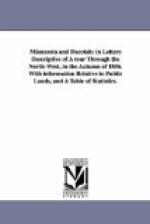There is considerable scrub oak also thinly scattered
over large portions of fertile prairie. To a
casual observer these oaks, from their stunted appearance,
would be taken as evidence of poor soil. But
the soil is not the cause of their scrubby looks.
It is the devouring fires which annually sweep over
the plains with brilliant though terrific aspect,
and which are fed by the luxuriant grass grown on
that same soil. If the oaks did not draw uncommon
nourishment from the soil, it must be difficult for
them to survive such scorchings. It is a consoling
thought that these fires cease in proportion as the
country is settled up. The rock maple is indigenous
to the soil; and the Indians have long been in the
habit of making sugar from its sap. The timber
most used for fences is tamarack. The pineries
may be said to begin at the mouth of the Crow Wing
River; though there is a great supply on the Rum River.
For upwards of a hundred miles above here on the Mississippi—
more or less dense, the pine forests extend. Captain
John Pope, in the interesting report of his expedition
to the Red River of the North, in 1849, says—
" The pineries of the upper Mississippi are mostly
upon its tributaries, and I think are not found on
the west side further south than the parallel of 46
degrees N. latitude.” (The latitude of this
place is 46 degrees 16’ 50".) “They alternate,
even where most abundant, with much larger tracts of
fertile country.” Again he says—
“As might be expected from its alluvial character,
there is no pine timber in the valley of the Red River,
but the oak and elm there attain to a size which I
do not think I have ever seen elsewhere.”
In another place he remarks that “the pineries
along the Crow Wing River are among the most extensive
and valuable found on the tributaries of the Mississippi.”
Mr. Schoolcraft says of this river, “the whole
region is noted for its pine timber.” In
speaking of the country on the St. Louis River, a few
miles from where it empties into Lake Superior, the
same gentleman remarks: “The growth of
the forest is pines, hemlock, spruce, birch, oak, and
maple.” I had heard considerable about Minnesota
lumber, it is true, but I was not prepared to see
the pine timber so valuable and heavy as it is above
and about here. The trees are of large growth,
straight and smooth. They are not surpassed by
“The
tallest pine,
Hewn on Norwegian hills to be the mast
Of some great admiral.”
Cujus est solum ejus est usque ad caelum— whose the soil, his to the sky— is a maxim in these pine regions of literal importance. There is something besides utility also to be mentioned in this connection. With the exception of swamps, which are few and far between, the timber land has all the beauty of a sylvan grove. The entire absence of underbrush and decayed logs lends ornament and attraction to the woods. They are more like the groves around a mansion in their neat and cheerful appearance; and awaken reflection on the Muses and the dialogues of philosophers rather than apprehension of wild beasts and serpents.




